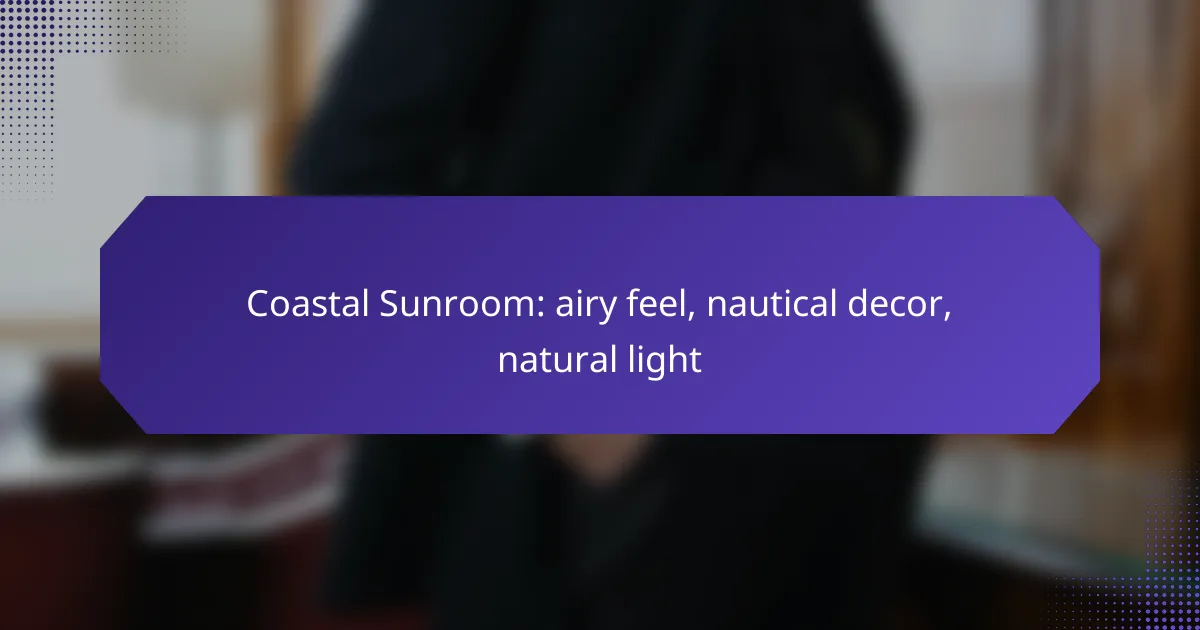Creating a coastal sunroom is an excellent way to bring the essence of the seaside into your home, emphasizing natural light and a breezy atmosphere. By incorporating nautical decor and maximizing large windows, you can craft a serene space that invites the outdoors in while enhancing your home’s aesthetic appeal. This inviting area not only boosts your living environment but also increases your home’s value, making it a worthwhile investment for any homeowner.

How to design a Coastal Sunroom in Canada?
Designing a coastal sunroom in Canada involves maximizing natural light and incorporating nautical decor to create an airy, inviting space. Focus on large windows, light colors, and effective ventilation to enhance the overall ambiance.
Incorporate large windows for natural light
Large windows are essential for a coastal sunroom, allowing ample natural light to flood the space. Consider floor-to-ceiling windows or expansive sliding glass doors that connect the indoors with the outdoors.
When selecting windows, opt for energy-efficient models that can withstand Canadian weather conditions. Double or triple glazing can help maintain temperature and reduce energy costs.
Use nautical decor elements
Nautical decor is key to achieving a coastal vibe. Incorporate elements like driftwood furniture, marine-themed artwork, and fabrics in shades of blue and white to evoke the seaside atmosphere.
Consider accessories such as seashells, ropes, and lanterns to enhance the nautical theme. These decorative touches can be easily swapped out seasonally to refresh the look of your sunroom.
Choose light, airy color palettes
A light and airy color palette is crucial for creating a coastal sunroom. Soft whites, pale blues, and sandy beiges can help reflect light and create a serene environment.
Use these colors on walls, furniture, and textiles to maintain a cohesive look. Avoid dark colors that can make the space feel smaller and less inviting.
Optimize for ventilation
Good ventilation is vital for a comfortable sunroom, especially during warmer months. Incorporate operable windows, ceiling fans, or even a small air conditioning unit to keep the air circulating.
Consider cross-ventilation by placing windows on opposite walls. This allows for a refreshing breeze, making your sunroom a pleasant retreat throughout the year.

What are the benefits of a Coastal Sunroom?
A Coastal Sunroom offers numerous benefits, including increased natural light, a serene environment, enhanced home value, and a strong connection to the outdoors. These features make it an appealing addition for those seeking a bright and airy living space that reflects a nautical theme.
Enhances natural light exposure
Coastal Sunrooms are designed to maximize natural light, often featuring large windows and glass doors that invite sunlight in. This exposure not only brightens the space but can also help reduce reliance on artificial lighting during the day.
When planning a Coastal Sunroom, consider the orientation of the room. South-facing sunrooms typically receive the most sunlight throughout the day, making them ideal for enjoying warm, sunlit afternoons.
Provides a relaxing atmosphere
The airy feel of a Coastal Sunroom creates a calming environment, perfect for relaxation and leisure. Soft colors, comfortable furniture, and nautical decor can enhance this tranquil space, making it an ideal spot for reading or enjoying a cup of coffee.
Incorporating elements like natural wood finishes and marine-themed accessories can further promote a soothing atmosphere, allowing you to unwind while surrounded by the beauty of nature.
Increases home value
Adding a Coastal Sunroom can significantly boost your home’s market value. Buyers often appreciate the extra living space and the aesthetic appeal of a sunroom filled with natural light.
When considering this addition, ensure it complements the overall style of your home. A well-designed sunroom can yield a return on investment that ranges from moderate to substantial, depending on local real estate trends.
Offers a connection to nature
A Coastal Sunroom provides an excellent way to connect with the outdoors while remaining sheltered from the elements. The expansive windows allow for unobstructed views of your garden or coastal scenery, creating a seamless transition between indoor and outdoor spaces.
To enhance this connection, consider adding potted plants or a small herb garden inside the sunroom. This not only brings nature closer but also improves air quality and adds a touch of greenery to your decor.

What materials are best for a Coastal Sunroom?
For a Coastal Sunroom, the best materials combine durability, aesthetic appeal, and functionality. Key options include vinyl, wood, and glass, each offering unique benefits that enhance the airy feel and nautical decor typical of coastal designs.
Vinyl for durability
Vinyl is an excellent choice for a Coastal Sunroom due to its resistance to moisture and UV damage, making it ideal for humid coastal environments. It requires minimal maintenance, which is a significant advantage for homeowners looking to enjoy their sunroom without constant upkeep.
When selecting vinyl, look for high-quality options that mimic the look of wood or other natural materials. This can help maintain the coastal aesthetic while ensuring longevity and ease of care.
Wood for a warm aesthetic
Wood brings a natural warmth and charm to a Coastal Sunroom, enhancing its inviting atmosphere. Popular choices include cedar and pine, which resist decay and can withstand coastal conditions when properly treated.
Consider using reclaimed wood for an eco-friendly option that adds character. Regular maintenance, such as sealing and staining, will help protect the wood from moisture and prolong its life.
Glass for unobstructed views
Glass is essential for maximizing natural light and providing unobstructed views of the surrounding landscape in a Coastal Sunroom. Large windows or sliding glass doors can create a seamless transition between indoor and outdoor spaces.
When choosing glass, consider energy-efficient options like double-glazed or low-E glass to improve insulation and reduce heating costs. This is particularly important in regions with variable climates, ensuring comfort year-round while maintaining the sunroom’s bright, airy feel.

How to choose the right location for a Coastal Sunroom?
Choosing the right location for a coastal sunroom involves considering factors like sunlight exposure, privacy, and proximity to existing structures. These elements will help create a bright, airy space that complements your home and enhances your coastal lifestyle.
Consider sunlight exposure
Sunlight exposure is crucial for a coastal sunroom, as it maximizes natural light and warmth. Ideally, position the sunroom facing south or southwest to capture the most sunlight throughout the day. This orientation not only brightens the space but also helps in reducing heating costs during colder months.
Additionally, consider the seasonal changes in sunlight. In summer, the sun is higher in the sky, while in winter, it is lower. Using overhangs or awnings can help manage the amount of direct sunlight entering the room, preventing overheating in warmer months.
Evaluate privacy from neighbors
Privacy is an important aspect when selecting a location for your coastal sunroom. Assess the distance between your property and neighboring homes to ensure a comfortable level of seclusion. If your sunroom is too close to a neighbor’s property, consider adding landscaping or privacy screens to create a more intimate atmosphere.
Also, think about the views from your sunroom. A location that offers scenic vistas while maintaining privacy can enhance your enjoyment of the space. Use strategic plantings or decorative panels to block unwanted sightlines without obstructing desirable views.
Assess proximity to existing structures
The location of your coastal sunroom should be evaluated in relation to existing structures on your property. Ensure that it is easily accessible from your main living areas, such as the kitchen or living room, to facilitate movement and use. A well-placed sunroom can serve as a natural extension of your home.
Consider the potential impact of nearby structures on your sunroom’s light and airflow. Avoid placing the sunroom too close to tall buildings or trees that may cast shadows or block breezes. A good rule of thumb is to maintain a distance that allows for unobstructed light and ventilation, enhancing the overall comfort of the space.

What are the costs associated with building a Coastal Sunroom?
Building a Coastal Sunroom typically ranges from the low tens of thousands to higher amounts, depending on various factors such as size, materials, and location. It’s essential to consider both initial construction costs and ongoing maintenance when planning your sunroom project.
Average cost per square foot in Canada
The average cost per square foot for a Coastal Sunroom in Canada generally falls between CAD 200 and CAD 400. This price can vary based on the complexity of the design and the quality of materials used. For instance, a more elaborate sunroom with high-end finishes may push costs toward the upper end of this range.
Factors affecting construction costs
Several factors influence the overall construction costs of a Coastal Sunroom. Key elements include the size of the sunroom, the type of foundation required, and the choice of windows and roofing materials. Additionally, local labor rates and any necessary permits can significantly impact the final price.
Seasonal considerations can also play a role; building during peak construction months may lead to higher labor costs. It’s advisable to obtain multiple quotes from contractors to ensure competitive pricing.
Potential financing options
Financing a Coastal Sunroom can be approached through various methods. Home equity loans or lines of credit are popular choices, allowing homeowners to borrow against their existing property value. Alternatively, personal loans or specialized home improvement financing can also be considered.
Some contractors may offer financing plans directly, which can simplify the payment process. Always compare interest rates and terms to find the most favorable option for your budget.










